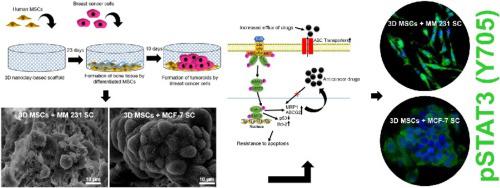Colloids and Surfaces B: Biointerfaces ( IF 5.4 ) Pub Date : 2020-06-26 , DOI: 10.1016/j.colsurfb.2020.111224 Sumanta Kar 1 , Dinesh R Katti 1 , Kalpana S Katti 1

|
Metastatic breast cancer cells on arriving at bone site interact with the bone cells to influence their growth, proliferation, and chemoresistance. There are currently no effective therapeutics available in the clinic for bone metastases. Many existing anti-cancer therapeutics are ineffective at the metastatic bone site due to a lack of accurate models of breast cancer bone metastasis for drug screening. Here, we report the development of an effective in vitro model using osteogenically differentiated human mesenchymal stem cells (MSCs) and human breast cancer cells on 3D nanoclay scaffolds as a testbed for screening drugs. Our results demonstrate that breast cancer cells grown in 3D bone-mimetic scaffolds exhibited altered physiological and biochemical properties, including tumoroids formation, elevated levels of cytokine such as IL-6, and its downstream effector-mediated inhibition of apoptosis and upregulation of multidrug transporters proteins, leading to drug resistance against paclitaxel. Most importantly, Signal Transducer and Activator of Transcription 3 (STAT3), a potential biomarker for chemoresistance in many cancers, was activated in the 3D breast cancer bone metastasis model. Thus, our data suggest that 3D bone-mimetic nanoclay scaffolds-based in vitro tumor model is a promising testbed for screening new therapeutics for breast cancer bone metastasis where bone interface governs drug resistance in breast cancer cells.
中文翻译:

骨界面调节乳腺癌骨转移中的耐药性。
到达骨部位的转移性乳腺癌细胞与骨细胞相互作用以影响它们的生长、增殖和化学抗性。目前临床上没有有效的治疗骨转移的药物。由于缺乏用于药物筛选的乳腺癌骨转移的准确模型,许多现有的抗癌疗法在转移性骨部位无效。在这里,我们报告了一种有效的体外在 3D 纳米粘土支架上使用成骨分化的人间充质干细胞 (MSCs) 和人乳腺癌细胞作为筛选药物的试验台。我们的研究结果表明,在 3D 骨模拟支架中生长的乳腺癌细胞表现出改变的生理和生化特性,包括类肿瘤形成、细胞因子(如 IL-6)水平升高,以及其下游效应子介导的细胞凋亡抑制和多药转运蛋白的上调,导致对紫杉醇产生耐药性。最重要的是,信号转导和转录激活因子 3 (STAT3) 是许多癌症中化学抗性的潜在生物标志物,在 3D 乳腺癌骨转移模型中被激活。因此,我们的数据表明,基于体外的 3D 仿骨纳米粘土支架肿瘤模型是筛选乳腺癌骨转移新疗法的有前景的试验平台,其中骨界面控制乳腺癌细胞的耐药性。











































 京公网安备 11010802027423号
京公网安备 11010802027423号